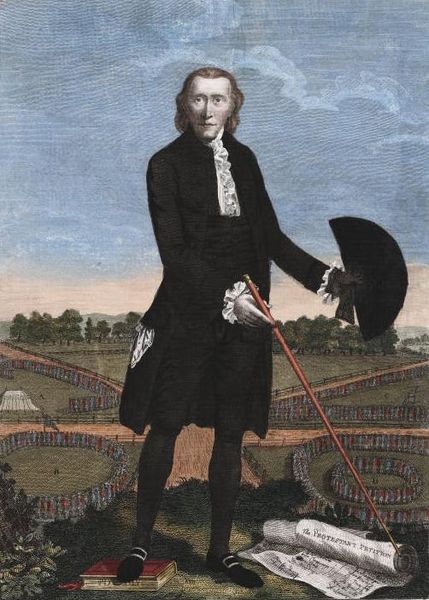Birth of Lord George Gordon
Lord George Gordon was born on December 26th, 1751.

The chiefs of the Gordons, Marquesses of Huntly and subsequently Dukes of Gordon, had a long and colourful history in Scotland. In the later eighteenth century they were considered possibly the greatest subjects in Britain, in terms of the number of people who lived under their rule and protection. Horace Walpole thought all of them were mad. Lord George Gordon, the youngest child of the 3rd duke, was born in London. Only seven months old when his father died, he was brought up by his widowed mother, herself a Gordon, on the family’s vast estates in Scotland. He was sent to school at Eton and then into the Navy for a time before he became an MP. An erratic character, vain, emotional and prone to demagoguery and unexpected enthusiasms, he was scarcely known until the Protestant Associations were formed to campaign for repeal of the Catholic Relief Act of 1778, which diminished discrimination against Roman Catholics.
Lord George’s own forebears had been Catholics for generations and he was no fanatic, but he had spoken out against the Relief Act in Scotland and the London Protestant Association chose him as its president. He seems to have accepted the position as a chance to shine as a leader of popular feeling. On June 2nd, 1780, he led a march of more than 50,000 people to the Houses of Parliament to present a monster petition. The demonstration set off an explosion of mob violence that lasted for days. To screams of ‘No Popery’, Roman Catholics were attacked and their houses destroyed, and Roman Catholic chapels were smashed and looted.
Lord George and the respectable elements in the Association were horrified. They put a notice in the newspapers calling on ‘all true Protestants ... to shew their attachment to their best interests, by a legal and peaceable deportment.’ This did nothing to stop the trouble, as the poor, who did not read the newspapers, came swarming out of the rookeries in St Giles, Spitalfields and Shoreditch to drink, loot and cause mayhem. There were murders and rapes, the Irish colony in Moorfields was attacked and hundreds of houses were burned down. A mob armed with muskets assaulted the Bank of England. Newgate and other prisons were stormed and the occupants released. Toughs and criminals armed with hammers and axes went on the rampage until forcibly put down by the troops Lord North’s government ordered into action.
Hundreds of people were killed and hundreds arrested, of whom twenty-five were eventually executed.
These did not include Lord George, who was held in the Tower of London for some months and then tried in Westminster Hall on a charge of raising and levying war against George III. He was acquitted on the ground that he had not intended any treason. The Gordon Riots, however, which showed how easily a big political gathering could erupt out of control into terrifying mass violence, sent a chill down the collective spine of the English propertied and ruling classes that lasted for years and helped to inspire repressive legislation and harden resistance to reform.
Over the following years Lord George was in constant hot water and his sanity was increasingly questioned. The Archbishop of Canterbury excommunicated him in 1786, in which year he converted to Judaism. Taking up the cause of the impostor Cagliostro, he was convicted of libelling the Queen of France, the French ambassador and the English system of justice, and imprisoned in Newgate. There he lived fairly comfortably, hosting dinner parties and entertaining his guests by playing the bagpipes, until he died of gaol fever in 1793, aged forty-one.




